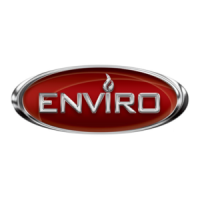ENVIRO-TEC
6
FORM ET115.24-NOM11 (118)
COOLING/HEATING MEDIUM CONNECTIONS
Toxic residues and loose particles
resulting from manufacturing and
eld piping techniques such as joint
compounds, soldering ux, and metal
shavings may be present in the unit
and the piping system. Not for use with
domestic or potable water systems.
Submittals and Product Catalogs detailing unit operation,
controls, and connections should be thoroughly
reviewed BEFORE beginning the connection of the
various cooling and/or heating mediums to the unit.
All accessory valve packages should be installed as
required, and all service valves should be checked for
proper operation.
If coil and valve package connections are to be made
with “sweat” or solder joint, care should be taken to
assure that no components in the valve package are
subjected to a high temperature which may damage seals
or other materials. Many two-position electric control
valves, depending on valve operation, are provided with
a manual-opening lever. This lever should be placed
in the “open” position during all soldering or brazing
operations. Valve bodies should be wrapped with a wet
rag to help dissipate heat encountered during brazing.
If the valve package connection at the coil is made with
a union, the coil side of the union must be prevented
from twisting (“backed up”) during tightening to prevent
damage to the coil tubing. Over-tightening must be
avoided to prevent distorting the union seal surface
and destroying the union. Due to the diversity of valve
packages for this product, install the valve packages with
no leaks or interference between components during
operation and maintenance. In the case of eld installed
valves and piping, the chilled water valve cluster (or
metering device on DX units) should be installed in
such a way that any dripping or sweating is contained
in the auxiliary drain pan or other device. Valves and
TXV’s should be secured or supported to avoid damage
to coil headers or distributor tubes. All valves, pipes,
and components must be suciently supported to ensure
structural integrity and proper operation of the unit.
All water coils must be protected from
freezing after initial lling with water.
Even if the system is drained, unit coils
may still hold enough water to cause
damage when exposed to temperatures
below freezing.
Refrigerant systems should be tested with dry nitrogen
rather than air to prevent the introduction of moisture
into the system. In the event that leaking or defective
components are discovered, the Sales Representative
must be notied BEFORE any repairs are attempted.
All leaks should be repaired before proceeding with
the installation.
Figure 3a-3d: Typical auxiliary drain pan removal
Figure 3a
Figure 3b
Figure 3c
Figure 3d

